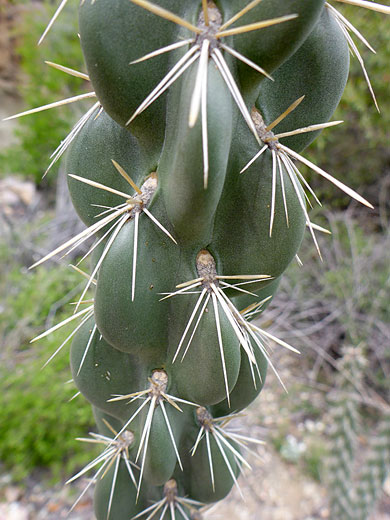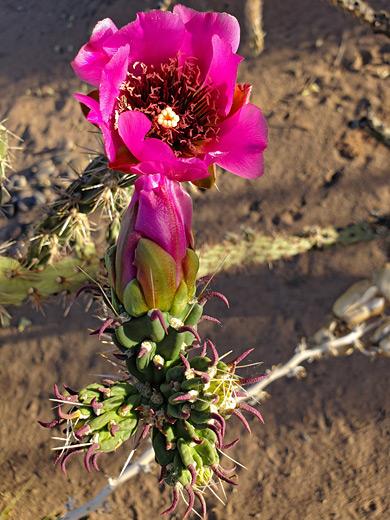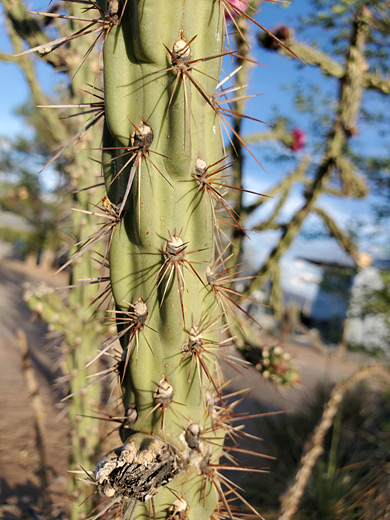Scientific name:
Cylindropuntia imbricata, or opuntia imbricata
Common name:
Tree cholla, walking stick cholla
Range:
South Colorado, all across New Mexico, west Texas, far southeast Arizona, west Oklahoma, west Kansas
Form:
Tall, branched clumps with a central trunk
Habitat:
Varied; grassland, scrubland, woodland, hillsides
Flowers:
Pink, violet; blooming May to August, April for var argentea

Distribution map for cylindropuntia imbricata
Cylindropuntia imbricata, tree cholla, is found in a wide range of environments, from the hot Chihuahuan Desert of west Texas to the southern Rocky Mountains in Colorado, elevations above 6,000 feet. It has stout, quite thick branches (stem segments are up to 15 inches long and 2 inches wide), bearing fairly short white or light yellow spines, eight to 20 per areole, that allow the green stem color (purplish in times of cold weather) to be clearly visible, and the plant reaches heights of 15 feet, with most stems quite high above the ground, supported by a strong central trunk. Plants towards the north of the range tend to have shorter stems, and more spines.
The attractive violet-pink flowers have fewer, broader tepals than some other cholla species, and open more widely. Filaments are green around the base, pale pink above; anthers are creamy yellow. The lobed stigma is creamy-white or pale green. Flowers are followed by knobbly, spineless, yellow-green fruits that stay attached to the plant for many months.
Spines grow from the top of elongated, well-spaced tubercles, which help differentiate the plant from similar species in its range, principally the cane cholla, for which the tubercles are much shorter.
There are two varieties of cylindropuntia imbricata. Most plants are var imbricata; these are tall, 10 feet or more at maturity, with stem segments up to 15 inches, and widely-spaced tubercles. Var argentea, found only in Big Bend National Park (west Texas), is smaller, at most 4 feet tall, with stem segments up to 7 inches, and closely-spaced tubercles.
The attractive violet-pink flowers have fewer, broader tepals than some other cholla species, and open more widely. Filaments are green around the base, pale pink above; anthers are creamy yellow. The lobed stigma is creamy-white or pale green. Flowers are followed by knobbly, spineless, yellow-green fruits that stay attached to the plant for many months.
Spines grow from the top of elongated, well-spaced tubercles, which help differentiate the plant from similar species in its range, principally the cane cholla, for which the tubercles are much shorter.
There are two varieties of cylindropuntia imbricata. Most plants are var imbricata; these are tall, 10 feet or more at maturity, with stem segments up to 15 inches, and widely-spaced tubercles. Var argentea, found only in Big Bend National Park (west Texas), is smaller, at most 4 feet tall, with stem segments up to 7 inches, and closely-spaced tubercles.
All Contents © Copyright The American Southwest | Comments and Questions | Contribute | Affiliate Marketing Disclosure | Site Map










